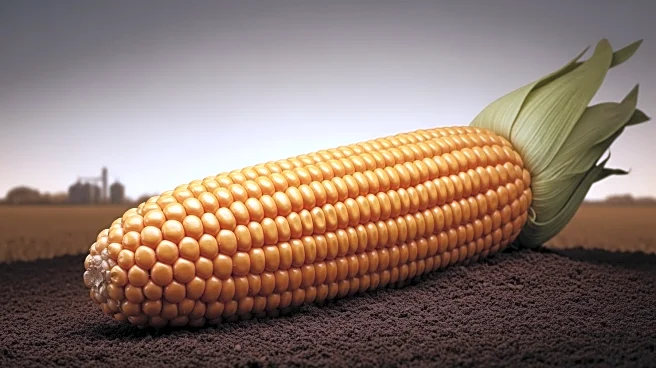What's Happening?
The United States Department of Agriculture (USDA) has released its September Grain Stocks report, revealing that U.S. old-crop corn stocks as of September 1, 2025, are at 1.532 billion bushels. This figure is down 13% from the previous year but exceeds the average trade expectation of 1.336 billion bushels. The report also indicates that soybean stocks are at 316 million bushels, an 8% decrease from the previous year, and below the expected 322 million bushels. Additionally, U.S. wheat stocks are reported at 2.12 billion bushels, surpassing the average trade expectation of 2.041 billion bushels and marking a 6% increase from the previous year. The USDA has also adjusted the 2024 corn and soybean production estimates, increasing corn production by 25 million bushels and soybean production by 7.74 million bushels.
Why It's Important?
The USDA's report has significant implications for the agricultural market, particularly for corn and wheat. The larger than expected corn and wheat inventories suggest a bearish outlook for these commodities, potentially leading to lower prices. This could benefit end users who may secure cheaper corn, especially as early harvest yields are reportedly lower due to disease. The adjustments in production estimates for 2024 also provide a cushion for supply, which may influence future market dynamics and pricing strategies. The report's findings are crucial for farmers, traders, and policymakers as they navigate the complexities of supply and demand in the agricultural sector.
What's Next?
The market is likely to react to these new figures, with potential adjustments in pricing and trading strategies. The USDA's future World Agricultural Supply and Demand Estimates (WASDE) reports will be closely watched for further yield adjustments, particularly in light of the current disease impacts on corn yields. Stakeholders in the agricultural industry, including farmers and commodity traders, will need to consider these developments in their planning and operations. The increased production estimates for 2024 may also influence planting decisions and resource allocation in the coming seasons.
Beyond the Headlines
The USDA's report highlights the ongoing challenges in accurately forecasting agricultural production and inventory levels. The unexpected adjustments in corn and soybean production estimates underscore the complexities of agricultural forecasting, influenced by factors such as weather conditions, disease, and market demand. These dynamics not only affect domestic markets but also have implications for international trade, as the U.S. is a major exporter of these commodities. The report may prompt discussions on improving data collection and forecasting methods to better anticipate market needs and support agricultural stakeholders.











